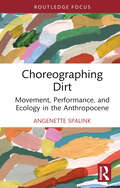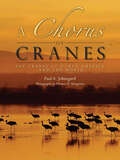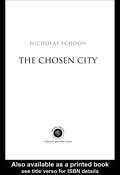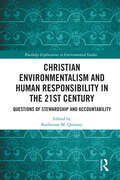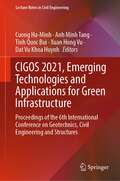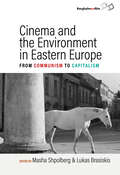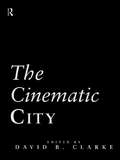- Table View
- List View
Choreographing Dirt: Movement, Performance, and Ecology in the Anthropocene (Routledge Studies in Theatre, Ecology, and Performance)
by Angenette SpalinkThis book is an innovative study that places performance and dance studies in conversation with ecology by exploring the significance of dirt in performance. Focusing on a range of 20th- and 21st-century performances that include modern dance, dance-theatre, Butoh, and everyday life, this book demonstrates how the choreography of dirt makes biological, geographical, and cultural meaning, what the author terms "biogeocultography". Whether it’s the Foundling Father digging into the earth’s strata in Suzan-Lori Park’s The America Play (1994), peat hurling through the air in Pina Bausch’s The Rite of Spring (1975), dancers frantically shovelling out fistfuls of dirt in Eveoke Dance Theatre’s Las Mariposas (2010), or Butoh performers dancing with fungi in Iván-Daniel Espinosa’s Messengers Divinos (2018), each example shows how the incorporation of dirt can reveal micro-level interactions between species – like the interplay between microscopic skin bacteria and soil protozoa – and macro-level interactions – like the transformation of peat to a greenhouse gas. By demonstrating the stakes of moving dirt, this book posits that performance can operate as a space to grapple with the multifaceted ecological dilemmas of the Anthropocene. This book will be of broad interest to both practitioners and researchers in theatre, performance studies, dance, ecocriticism, and the environmental humanities.
Choreographing Dirt: Movement, Performance, and Ecology in the Anthropocene (Routledge Studies in Theatre, Ecology, and Performance)
by Angenette SpalinkThis book is an innovative study that places performance and dance studies in conversation with ecology by exploring the significance of dirt in performance. Focusing on a range of 20th- and 21st-century performances that include modern dance, dance-theatre, Butoh, and everyday life, this book demonstrates how the choreography of dirt makes biological, geographical, and cultural meaning, what the author terms "biogeocultography". Whether it’s the Foundling Father digging into the earth’s strata in Suzan-Lori Park’s The America Play (1994), peat hurling through the air in Pina Bausch’s The Rite of Spring (1975), dancers frantically shovelling out fistfuls of dirt in Eveoke Dance Theatre’s Las Mariposas (2010), or Butoh performers dancing with fungi in Iván-Daniel Espinosa’s Messengers Divinos (2018), each example shows how the incorporation of dirt can reveal micro-level interactions between species – like the interplay between microscopic skin bacteria and soil protozoa – and macro-level interactions – like the transformation of peat to a greenhouse gas. By demonstrating the stakes of moving dirt, this book posits that performance can operate as a space to grapple with the multifaceted ecological dilemmas of the Anthropocene. This book will be of broad interest to both practitioners and researchers in theatre, performance studies, dance, ecocriticism, and the environmental humanities.
A Chorus of Cranes: The Cranes of North America and the World
by Paul A. Johnsgard“Since long before medieval times cranes have been considered messengers of the gods, calling annually from on high to remind humans below of the passing years and of their own mortality. Now it is up to humans to take responsibility for controlling our own fate—and also to cry out to protect not only cranes but all the other wonderful creatures that share our increasingly fragile and threatened planetary ecosystem with us." —Paul A. Johnsgard, from the acknowledgments Accompanied by the stunning photography of Thomas D. Mangelsen, A Chorus of Cranes details the natural history, biology, and conservation issues surrounding the abundant sandhill crane and the endangered whooping crane in North America. Author Paul A. Johnsgard, one of the leading authorities on cranes and crane biology, describes the fascinating social behaviors, beautiful natural habitats, and grueling seasonal migrations that have stirred the hearts of people as far back as medieval times and garnered the crane a place in folklore and mythology across continents. Johnsgard has substantially updated and significantly expanded his 1991 work Crane Music, incorporating new information on the biology and status of these two North American cranes and providing abbreviated summaries on the other thirteen crane species of the world. The stories of these birds and their contrasting fates provide an instructive and moving history of bird conservation in North America. A Chorus of Cranes is a gorgeous and invaluable resource for crane enthusiasts, birders, natural historians, and conservationists alike. The University Press of Colorado gratefully acknowledges the generous support of the Iain Nicholson Audubon Center at Rowe Sanctuary, Audubon Nebraska, Ron and Judy Parks, Wagon Tongue Creek Farm, and the Trull Foundation toward the publication of this book.
The Chosen City
by Nicholas SchoonThere is endless talk about the need for an urban renaissance; can it happen in the real world? In this broad, challenging and highly engaging book, Nicholas Schoon argues that the foremost priority for regeneration is to make neighbourhoods and cities places where people with choices choose to live.The author surveys the last two centuries of metropolitan growth and decay, analyzes the successes and failures of recent changes in urban policy and proposes a wide range of radical measures to make the renaissance a reality. Comprehensively researched, The Chosen City is a wake up call for everyone interested and involved in urban regeneration - degree students and academics, planning and housing professionals, architects, surveyors, developers and politicians. The text is illustrated with powerful black and white images from a leading national newspaper photographer.
The Chosen City
by Nicholas SchoonThere is endless talk about the need for an urban renaissance; can it happen in the real world? In this broad, challenging and highly engaging book, Nicholas Schoon argues that the foremost priority for regeneration is to make neighbourhoods and cities places where people with choices choose to live.The author surveys the last two centuries of metropolitan growth and decay, analyzes the successes and failures of recent changes in urban policy and proposes a wide range of radical measures to make the renaissance a reality. Comprehensively researched, The Chosen City is a wake up call for everyone interested and involved in urban regeneration - degree students and academics, planning and housing professionals, architects, surveyors, developers and politicians. The text is illustrated with powerful black and white images from a leading national newspaper photographer.
Chosen Legacies: Heritage in Regional Identity
by Linde EgbertsThe urge for regional identity has not declined in the process of globalization. Rather, heritage is used to develop regional distinctiveness and to charge identities with a past. Particularly helpful for this aim are creation stories, Golden Ages or recent, shared traumas. Some themes such as the Roman era or the Second World War appear easier to appropriate than, for example, prehistory. This book assesses the role of heritage in the construction of regional identities in Western Europe. It contains case studies on early medieval heritage in Alsace and Euregio-Meuse Rhine, industrial heritage in the German Ruhr area and competing memories in the Arnhem-Nijmegen region in the Netherlands. It presents new insights into the process of heritage production on a regional level in relationship to processes of identity construction. The theoretical analysis of "heritage" and "regional identity" is innovative as these concepts were hardly analysed in relation to each other before. This book also offers insights into policy, tourism, spatial development and regional development to policymakers, politicians, designers and professionals in the heritage and tourism industries.
Chosen Legacies: Heritage in Regional Identity
by Linde EgbertsThe urge for regional identity has not declined in the process of globalization. Rather, heritage is used to develop regional distinctiveness and to charge identities with a past. Particularly helpful for this aim are creation stories, Golden Ages or recent, shared traumas. Some themes such as the Roman era or the Second World War appear easier to appropriate than, for example, prehistory. This book assesses the role of heritage in the construction of regional identities in Western Europe. It contains case studies on early medieval heritage in Alsace and Euregio-Meuse Rhine, industrial heritage in the German Ruhr area and competing memories in the Arnhem-Nijmegen region in the Netherlands. It presents new insights into the process of heritage production on a regional level in relationship to processes of identity construction. The theoretical analysis of "heritage" and "regional identity" is innovative as these concepts were hardly analysed in relation to each other before. This book also offers insights into policy, tourism, spatial development and regional development to policymakers, politicians, designers and professionals in the heritage and tourism industries.
The Christian Consumer: Living Faithfully in a Fragile World
by Laura M. HartmanBe it fair trade coffee or foreign oil, our choices as consumers affect the well-being of humans around the globe, not to mention the natural world and of course ourselves. Consumption is a serious ethical issue, and Christian writers throughout history have weighed in, discussing topics such as affluence and poverty, greed and gluttony, and proper stewardship of resources. These voices are often at odds, however. In this book, Laura M. Hartman formulates a coherent Christian ethic of consumption, imposing order on the debate by dividing it into four imperatives: Christians are to consume in ways that avoid sin, embrace creation, love one's neighbor, and envision the future. An adequate ethics of consumption, she argues, must include all four considerations as tools for discernment, even when they seem to contradict one another. The book includes discussions of Christian practices such as fasting, gratitude, solidarity, gift-giving, Sabbath-keeping, and the Eucharist. Using exemplars from the Christian tradition and practical examples from everyday life, The Christian Consumer offers a thoughtful guide to ethical consumption.
The Christian Consumer: Living Faithfully in a Fragile World
by Laura M. HartmanBe it fair trade coffee or foreign oil, our choices as consumers affect the well-being of humans around the globe, not to mention the natural world and of course ourselves. Consumption is a serious ethical issue, and Christian writers throughout history have weighed in, discussing topics such as affluence and poverty, greed and gluttony, and proper stewardship of resources. These voices are often at odds, however. In this book, Laura M. Hartman formulates a coherent Christian ethic of consumption, imposing order on the debate by dividing it into four imperatives: Christians are to consume in ways that avoid sin, embrace creation, love one's neighbor, and envision the future. An adequate ethics of consumption, she argues, must include all four considerations as tools for discernment, even when they seem to contradict one another. The book includes discussions of Christian practices such as fasting, gratitude, solidarity, gift-giving, Sabbath-keeping, and the Eucharist. Using exemplars from the Christian tradition and practical examples from everyday life, The Christian Consumer offers a thoughtful guide to ethical consumption.
Christian Environmentalism and Human Responsibility in the 21st Century: Questions of Stewardship and Accountability (Routledge Explorations in Environmental Studies)
by Katherine M. QuinseyChristian Environmentalism and Human Responsibility in the 21st Century comprises original scholarly essays and creative works exploring the implications of Christian environmentalism through literary and cultural criticism and creative reflection. The volume draws on a flourishing recent body of Christian ecocriticism and environmental activity, incorporating both practical ethics and environmental spirituality, but with particular emphasis on the notion of human responsibility. It discusses responsibility in its dual sense, as both the recognized cause of environmental destruction and the ethical imperative of accountability to the nonhuman environment. The book crosses boundaries between traditional scholarly and creative reflection through a global range of topics: African oral tradition, Ohio artists off the grid, immigrant self-metaphors of land and sea, iconic writers from Milton to O’Connor to Atwood, and Indigenous Canadian models for listening to the nonhuman Mother of us all. In its incorporation of academic and creative pieces from scholars and creative artists across North America, this volume shows how environmental work of its nature and necessity crosses traditional academic and community boundaries. In both form and orientation, this collection speaks to the most urgent intellectual, physical, social, and spiritual needs of the present day. This book will appeal to scholars, researchers, and upper-level students interested in the relationship between religion and environment, ethics, animal welfare, poetry, memoir, and post-secularism.
Christian Environmentalism and Human Responsibility in the 21st Century: Questions of Stewardship and Accountability (Routledge Explorations in Environmental Studies)
by Katherine M. QuinseyChristian Environmentalism and Human Responsibility in the 21st Century comprises original scholarly essays and creative works exploring the implications of Christian environmentalism through literary and cultural criticism and creative reflection. The volume draws on a flourishing recent body of Christian ecocriticism and environmental activity, incorporating both practical ethics and environmental spirituality, but with particular emphasis on the notion of human responsibility. It discusses responsibility in its dual sense, as both the recognized cause of environmental destruction and the ethical imperative of accountability to the nonhuman environment. The book crosses boundaries between traditional scholarly and creative reflection through a global range of topics: African oral tradition, Ohio artists off the grid, immigrant self-metaphors of land and sea, iconic writers from Milton to O’Connor to Atwood, and Indigenous Canadian models for listening to the nonhuman Mother of us all. In its incorporation of academic and creative pieces from scholars and creative artists across North America, this volume shows how environmental work of its nature and necessity crosses traditional academic and community boundaries. In both form and orientation, this collection speaks to the most urgent intellectual, physical, social, and spiritual needs of the present day. This book will appeal to scholars, researchers, and upper-level students interested in the relationship between religion and environment, ethics, animal welfare, poetry, memoir, and post-secularism.
Christmas cactus (large print)
by RnibThis is an image of a Christmas cactus (Schlumbergera) in a pot.There is a locator dot shown, which will be at the top left of the page when the image is the correct way up.The plant pot is in the bottom centre of the page.The fleshy, flattened stems of the cactus branch out to the left and right from the top of the pot near the centre of the page. The cactus does not have any leaves or spines. The stems are oval shaped and about three centimetres long. They have serrated edges and join one to another to form long 'fronds' . The flowers grow at the tips and joints of the stems at the left and right of the page. Schlumbergera grow on rocks or trees (epiphytic) and like shade and high humidity. They are dicotyledons.
Christmas cactus (UEB contracted)
by RnibThis is an image of a Christmas cactus (Schlumbergera) in a pot.There is a locator dot shown, which will be at the top left of the page when the image is the correct way up.The plant pot is in the bottom centre of the page.The fleshy, flattened stems of the cactus branch out to the left and right from the top of the pot near the centre of the page. The cactus does not have any leaves or spines. The stems are oval shaped and about three centimetres long. They have serrated edges and join one to another to form long 'fronds' . The flowers grow at the tips and joints of the stems at the left and right of the page. Schlumbergera grow on rocks or trees (epiphytic) and like shade and high humidity. They are dicotyledons.
Christmas cactus (UEB uncontracted)
by RnibThis is an image of a Christmas cactus (Schlumbergera) in a pot.There is a locator dot shown, which will be at the top left of the page when the image is the correct way up.The plant pot is in the bottom centre of the page.The fleshy, flattened stems of the cactus branch out to the left and right from the top of the pot near the centre of the page. The cactus does not have any leaves or spines. The stems are oval shaped and about three centimetres long. They have serrated edges and join one to another to form long 'fronds' . The flowers grow at the tips and joints of the stems at the left and right of the page. Schlumbergera grow on rocks or trees (epiphytic) and like shade and high humidity. They are dicotyledons.
The Christopher Columbus Encyclopedia
by Silvio A. BedingThe European discovery of the Americas in 1492 was one of the most important events of the Renaissance, and with it Christopher Columbus changed the course of world history. Now, five hundred years later, this 2-volume reference work will chart new courses in the study and understanding of Columbus and the Age of Discovery. Much more than an account of the man and his voyages, The Christopher Columbus Encyclopedia is a complete A-Z look at the world during this momentous era. In two volumes, The Christopher Columbus Encyclopedia contains more than 350 signed original articles ranging from 250 to more than 10,000 words, written by nearly 150 contributors from around the world. The work includes cross-references, bibliographies for each article, and a comprehensive index. The work is fully illustrated, with hundreds of maps, drawings and photographs.
Chromium in Plants and Environment (Environmental Science and Engineering)
by Nitish Kumar Clemens Walther Dharmendra K. GuptaThis edited book brings together a diverse group of environmental science, sustainability, and health researchers to address the challenges posed by global mass poisoning caused by chromium contamination of soil and plants. In recent years, contamination of the environment by chromium has become a major concern. Chromium is a non-degradable, harmful, and toxic pollutant which negatively affects the environment. It is unique among the heavy metals found in industrial wastewater and sewage and sludge, as it may exist as a trivalent cation and as anion in the hexavalent state in the pH range of agricultural soils. It is used on a large scale in many different industries, including metallurgy, electroplating, production of paints and pigments, tanning, wood preservation, chemical production, and pulp and paper production. These industries are contributing larger amount of chromium, which can ultimately have significant adverse effects on biological and ecological activities of ecosystem. Chromium enters the food chain through consumption of plant material. A high concentration of chromium has been found to be harmful to vegetation. As the chromium concentration in plants increases, it adversely affects several biological parameters and eventually renders the soil barren.The book sheds light on this global environmental issue and proposes solutions to contamination through multi-disciplinary approaches and case studies from different parts of the world.This book is a valuable resource to students, academicians, researchers, and environmental professionals who are doing field work on chromium contamination throughout the world.
Chronology and Evolution of Mars: Proceedings of an ISSI Workshop, 10–14 April 2000, Bern, Switzerland (Space Sciences Series of ISSI #12)
by R. Kallenbach Johannes Geiss W. K. HartmannMars is about one-eighth the mass of the Earth and it may provide an analogue of what the Earth was like when it was at such an early stage of accretion. The fur ther growth of the Earth was sustained by major collisions with planetesimals and planets such as that which resulted in the formation ofthe Earth's moon (Hartmann and Davis, 1975; Cameron and Ward, 1976; Wetherill, 1986; Cameron and Benz, 1991). This late accretionary history, which lasted more than 50 Myr in the case of the Earth (Halliday, 2000a, b), appears to have been shorter and less catastrophic in the case of Mars (Harper et ai. , 1995; Lee and Halliday, 1997). In this article we review the basic differences between the bulk composition of Mars and the Earth and the manner in which this plays into our understanding of the timing and mechanisms of accretion and core formation. We highlight some of the evidence for early cessation of major collisional growth on Mars. Finally, we reevaluate the isotopic evidence that Mars differentiated quickly. Fundamental differences between the composition of Mars and that of other terrestrial planets are apparent from the planet's slightly lower density and from the compositions of Martian meteorites. The low density is partially explicable if there is a greater proportion of more volatile elements.
CIGOS 2019, Innovation for Sustainable Infrastructure: Proceedings of the 5th International Conference on Geotechnics, Civil Engineering Works and Structures (Lecture Notes in Civil Engineering #54)
This book presents selected articles from the 5th International Conference on Geotechnics, Civil Engineering Works and Structures, held in Ha Noi, focusing on the theme “Innovation for Sustainable Infrastructure”, aiming to not only raise awareness of the vital importance of sustainability in infrastructure development but to also highlight the essential roles of innovation and technology in planning and building sustainable infrastructure. It provides an international platform for researchers, practitioners, policymakers and entrepreneurs to present their recent advances and to exchange knowledge and experience on various topics related to the theme of “Innovation for Sustainable Infrastructure”.
CIGOS 2021, Emerging Technologies and Applications for Green Infrastructure: Proceedings of the 6th International Conference on Geotechnics, Civil Engineering and Structures (Lecture Notes in Civil Engineering #203)
by Cuong Ha-Minh Anh Minh Tang Tinh Quoc Bui Xuan Hong Vu Dat Vu Khoa HuynhThis book highlights the key role of green infrastructure (GI) in providing natural and ecosystem solutions, helping alleviate many of the environmental, social, and economic problems caused by rapid urbanization. The book gathers the emerging technologies and applications in various disciplines involving geotechnics, civil engineering, and structures, which are presented in numerous high-quality papers by worldwide researchers, practitioners, policymakers, and entrepreneurs at the 6th CIGOS event, 2021. Moreover, by sharing knowledge and experiences around emerging GI technologies and policy issues, the book aims at encouraging adoption of GI technologies as well as building capacity for implementing GI practices at all scales. This book is useful for researchers and professionals in designing, building, and managing sustainable buildings and infrastructure.
Cinema and the Environment in Eastern Europe: From Communism to Capitalism
by Masha Shpolberg and Lukas BrasiskisThe annexation of Eastern Europe to the Soviet sphere after World War II dramatically reshaped popular understandings of the natural environment. With an eco-critical approach, Cinema and the Environment in Eastern Europe breaks new ground in documenting how filmmakers increasingly saw cinema as a tool to critique the social and environmental damage of large-scale projects from socialist regimes and newly forming capitalist presences. New and established scholars with backgrounds across Europe, the United States, and Australia come together to reflect on how the cultural sphere has, and can still, play a role in redefining our relationship to nature.
Cinema and the Environment in Eastern Europe: From Communism to Capitalism
by Masha Shpolberg Lukas BrasiskisThe annexation of Eastern Europe to the Soviet sphere after World War II dramatically reshaped popular understandings of the natural environment. With an eco-critical approach, Cinema and the Environment in Eastern Europe breaks new ground in documenting how filmmakers increasingly saw cinema as a tool to critique the social and environmental damage of large-scale projects from socialist regimes and newly forming capitalist presences. New and established scholars with backgrounds across Europe, the United States, and Australia come together to reflect on how the cultural sphere has, and can still, play a role in redefining our relationship to nature.
Cinema and the Environment in Eastern Europe: From Communism to Capitalism
The annexation of Eastern Europe to the Soviet sphere after World War II dramatically reshaped popular understandings of the natural environment. With an eco-critical approach, Cinema and the Environment in Eastern Europe breaks new ground in documenting how filmmakers increasingly saw cinema as a tool to critique the social and environmental damage of large-scale projects from socialist regimes and newly forming capitalist presences. New and established scholars with backgrounds across Europe, the United States, and Australia come together to reflect on how the cultural sphere has, and can still, play a role in redefining our relationship to nature.
Cinematic Cartography: Scale, Analysis, Topography (Routledge Spatial Humanities Series)
by Chris LukinbealThis book uniquely bridges the conceptual gap between the history of geographic, cartographic thought, and film theory with the technological and cultural shifts that shaped the emergence of cameras and cinema.Adorned with illustrative figures, examples, and case studies throughout, the book explores how cinema lends itself to cartography and, in turn, how cartography relates to both the individual and collective experience of cinema. By using cartography to understand space and scale in film, the book moves away from textual analysis or representation analysis to focus on the locational attribution of the sites where the cinematic landscape is being produced. It contends that viewers of moving images are active players in a complex network of cultural and mental geographies.This volume is essential reading for students, scholars, and academics of cinematography, human, cultural, and social geography, cartography, and media studies, as well as those interested in these areas more generally.
Cinematic Cartography: Scale, Analysis, Topography (Routledge Spatial Humanities Series)
by Chris LukinbealThis book uniquely bridges the conceptual gap between the history of geographic, cartographic thought, and film theory with the technological and cultural shifts that shaped the emergence of cameras and cinema.Adorned with illustrative figures, examples, and case studies throughout, the book explores how cinema lends itself to cartography and, in turn, how cartography relates to both the individual and collective experience of cinema. By using cartography to understand space and scale in film, the book moves away from textual analysis or representation analysis to focus on the locational attribution of the sites where the cinematic landscape is being produced. It contends that viewers of moving images are active players in a complex network of cultural and mental geographies.This volume is essential reading for students, scholars, and academics of cinematography, human, cultural, and social geography, cartography, and media studies, as well as those interested in these areas more generally.
The Cinematic City
by David ClarkeThe Cinematic City offers an innovative and thought-provoking insight into cityscape and screenscape and their inter-connection. Illustrated throughout with movie stills, a diverse selection of films (from 'Bladerunner' to 'Little Caesar'), genres, cities and historical periods are examined by leading names in the field. The key dimensions of film and urban theory are introduced before detailed analysis of the various cinematic forms which relate most significantly to the city. From early cinema and documentary film, to film noir, 'New Wave' and 'postmodern cinema', the contributors provide a wealth of empirical material and illustration whilst drawing on the theoretical insights of contemporary feminism, Benjamin, Baudrillard, Foucault, Lacan, and others. The Cinematic City shows how the city has been undeniably shaped by the cinematic form, and how cinema owes much of its nature to the historical development of urban space. Engaging with current theoretical debates, this is a book that is set to change the way in which we think about both the nature of the city and film. Contributors: Giuliana Bruno, Iain Chambers, Marcus Doel, David Clarke, Anthony Easthope, Elisabeth Mahoney, Will Straw, Stephen Ward, John Gold, James Hay, Rob Lapsley, Frank Krutnik
